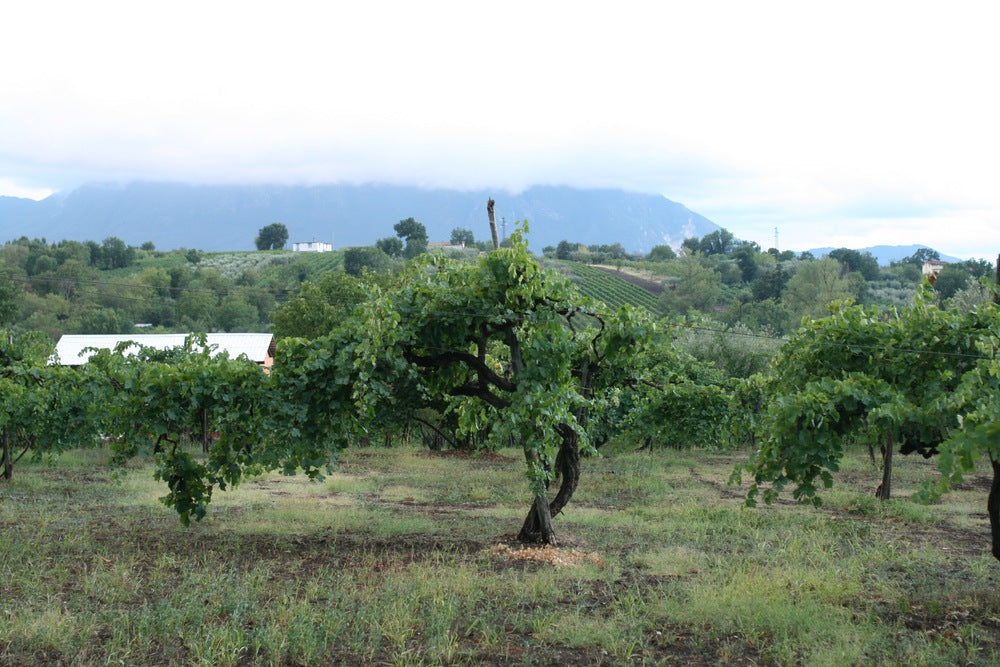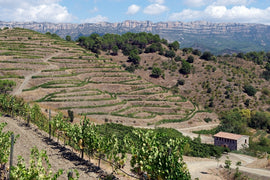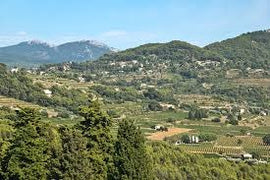CAMPANIA
The ‘shin' of Italy’s boot, Campania is one of the country’s oldest wine regions (the Greeks, Romans, and Byzantines all planted grapes here), anchored by its capital city, Naples. The name is derived from the Latin Campania Felix meaning ‘happy land or ‘fertile countryside’ - and while not affluent in the pecuniary sense (it ranks 18th out of 20 Italians regions in GDP), Campania is flush with the stuff most of us conjure when we contemplate Italy. Naples, the country’s third largest city (after Rome and Milan) is the historic capital of Baroque style, the cradle of pizza and pasta, home to Europe’s largest old town center (a UNESCO world heritage site) and some 500 domed churches dating back to the early Christian era. It sits in the shadow of Mt. Vesuvius, an active volcano whose 79 AD eruption created the famous ruins of Pompeii, and splashes into the Gulf of Naples, populated by the postcard islands of Capri, Ischia, and Procida. The city remains a vibrant culinary, cultural, and artistic hub today, with more Michelin starred restaurants than any other place in Italy, world famous palaces, museums, and public art, including street murals and celestial metro stations.
Venture outside Naples and Campania continues to astonish. There’s the famous Amalfi coast - 34 of Italy’s most fabled miles, where the towns of Sorrento, Positano, Amalfi itself, and Ravello stipple brightly coloured dwellings in, around and down the crags of jagged cliffs that pierce the azure brushstrokes of Tyrrhenian Sea and sky. Head further inland and you’ll discover no less eye-popping landscapes composed of verdant forests, hills, valleys, and mountains.
And everywhere, there are grape vines. Five provinces comprise Campania: Napoli, Avellino, Benevento, Caserta, and Salerno, and they all produce wine. Viticulture has flourished in the region’s abundant sunshine, hot and dry summers, mild winters, volcanic soil, and cool sea and mountain breezes since antiquity. The legendary Roman tipple Falernian for instance, ostensibly gifted by the wine god Bacchus to local farmer Falernus and famous enough in its day for several ancient sources to extol the 121 BC vintage in particular, comes from Campania. And if now no one can agree on its precise recipe, that’s in part because the region continues to host a feast of native varieties that date back to the ancients and are found virtually nowhere else.
This month we are focusing on one of the more obscure, a white grape called Coda di Volpe, which translates to ‘tail of the fox’, and so titled on account of its bushy, pendulous clusters. For centuries though, it was known as Falerno, as it was thought to be at least part of the source material for Falernian, giving it as much claim to the title of Italian Ur-Vine as any of its (slightly) more well known coevals like Falanghina or Fiano. Our winemaker here, Raeffalo Troisi of Valdeperti, was in fact the first in the world to bottle a single varietal Coda di Volpe.
Another variety rumored to be part of Falernian’s farrago is the red grape Aglianico, which remains Campania’s calling card today. Full bodied and late ripening enough that it cannot be grown any farther north, Aglianico is sometimes known as the ‘Barolo of the South’ due to its elegant tannins and aging potential. Indeed, Irpinia, the east-central area of Campania near Avellino where both of this month’s wines are grown and made, has weather, terroir and vegetation very similar to Piedmont, Barolo’s home in the North. Taurasi is the DOCG within Irpinia practically synonymous with Aglianico (though Aglianico di Vulture, from the bordering Basilicata region is also great) and, as its name suggests, the location of our red producer this month, Contrade di Taurasi. This bottling is 100% Aglianico from declassified Taurasi fruit, robust and age-worthy but with a freshness compatible with the Bay Area’s version of summer.
|
Vadiaperti Coda di Volpe ‘Torama’ 2020 |
|
|
Region: Montefredane, Campania |
About the Winery: Since the end of the nineteenth century, the Troisi family of Azienda Agricola Vadiaperti has championed the wines of Irpinia, a historic vine-growing region in southern Italy. Winemaker Raffaele Troisi is a vine grower from a generations-long line of passionate family members who dedicated their lives to the fruit of the vine. His grandfather and namesake Raffaele was the first Troisi to plant vines, with an eye to local varieties such as Fiano and Coda di Volpe. While Raffaele died young, his wife Elisa kept his vision alive, and over the decades, became one of the region’s most knowledgeable vine growers, a natural talent who could determine the health of her vines or the right time to harvest by sight and touch. It was Elisa’s son Antonio who took the family farm into the commercial realm, bottling in 1984 the very first single-variety Fiano wine. And Antonio’s son Raffaele—who today runs the family estate in Montefredane—worked side by side with his father in the cantina and the fields for years, before he took the reins himself in 1998. About the Winemaking: Estate vineyards are located in and around the town of Montefredane, from 1,200 to 2,100 feet above sea level. Soils combine clay, volcanic rock and well-draining tufo, which are all mineral-rich soils. Vines range from 25 to 70 years old. At these higher altitudes, harvest typically runs into mid-October.Grapes are harvested by hand and pressed full cluster, fermenting on indigenous yeasts in temperature-controlled, stainless steel tanks. Wines are aged on fine lees in tanks from between a few months to two years, depending on the wine. Tasting Notes: Aromas of citrus, tropical fruit, crushed stones. Weighty and concentrated, yet balanced; a vibrant, mineral core. |
|
Winemaker: Raffaele Troisi |
|
|
Price per bottle / per case $36.99 $399.50 |
|
|
Suggested Food Pairing: Risotto alla Pescatora, any type of rich seafood like lobster or soft shell crab with Garlic and Breadcrumbs, Burrata, Polenta with Black Pepper and Parmesan . |
|
|
Contrade di Taurasi Aglianico Irpinia DOC 2018 |
|
|
Region: Irpinia DOC |
About the Winery: Contrade di Taurasi is owned by Sandro Lonardo, a schoolteacher, and his wife Enza. They make Irpinia Aglianico, Taurasi, and small amounts of a white wine made from Grecomusc’, an indigenous white variety (grown ungrafted, interestingly). Their vineyards are all exposed directly south, which is ideal, and are at about 1300 feet above sea level, which may explain how a wine picked in the beginning of November in a warm climate can come in at relatively modest alcohol (between 13 and 13.5% in most vintages). About the Winemaking: 100% Aglianico from vines planted between 1985 and 1995 on southwest facing 350 mt elevation soil composed of volcanic tuff and limestone. Harvested in early November, with 20 days maceration and controlled low temperature fermentation in stainless steel with indigenous yeasts, followed by 12 months in oak puncheons. 8,000 bottles are produced annually. Certified organic farming. Tasting Notes: The Irpinia shows the distinctive flavors of the area - blackberry/raspberry fruit balanced with fresh acidity, a savory character that comes with volcanic soils, and a rounder, more forward structure than Taurasi itself. |
|
Winemaker: Sandro Lonardo |
|
|
Price per bottle / per case $29.99 $323.90 |
|
|
Suggested Food Pairing: Pizza, Hearty Pastas, Eggplant Parmesan, Barbecue Pork Ribs, Lamb & Bell Pepper Ragu, Spicy Sausage with White Bean, Garlic and Kale (see recipe). |
|
- 1 ⅓ cups vegetable stock
- 2 tablespoons olive oil
- 4 veggie sausages, sliced into one-inch pieces
- 1 medium shallot, small dice
- ¼ cup sun dried tomatoes, finely chopped
- 3 cloves garlic, minced
- 2 tablespoons nutritional yeast
- ½ teaspoon dried oregano
- ¼ teaspoon ground chillies (optional)
- sea salt and ground black pepper, to taste
- 1 teaspoon balsamic vinegar
- 4 cups chopped kale
- Vegan “parmesan”, for serving (optional)
- extra ground chillies or chili crisp, for serving
- In an upright blender, combine half of the beans and all of the vegetable stock. Blend this on high until completely smooth. Set aside.
- Set a large, deep skillet over medium heat. Pour in the olive oil and swirl it around. Place the sliced veggie sausages into the skillet and spread them out into a single layer. Brown the sausage pieces completely on one side and flip over. Brown the other side and then transfer them to a plate. This whole process should take 6-7 minutes.
- Return the skillet to medium heat. If you need to add more olive oil, drizzle it in. Add the shallots and sauté until very soft and translucent, about 5-6 minutes. If they are browning too fast, turn the heat down. To the skillet, add the sun-dried tomatoes, garlic, nutritional yeast, dried oregano, and chillies. Stir for about a minute.
- Add the remaining non-blended white beans to the skillet and stir. Season with salt and pepper. Pour in the puréed white bean and vegetable stock mixture and stir. Bring this to a boil and simmer until slightly reduced, about 5 minutes. Add the balsamic vinegar and kale and stir it up into the beans until the kale is wilted. The mixture should be quite thick at this point! Season with salt and pepper again if necessary.
- Add the browned veggie sausage back into the skillet and stir it up a bit. Serve the veggie sausage and white bean skillet immediately with crusty bread, vegan “parmesan” and extra ground chillies or chili crisp.





